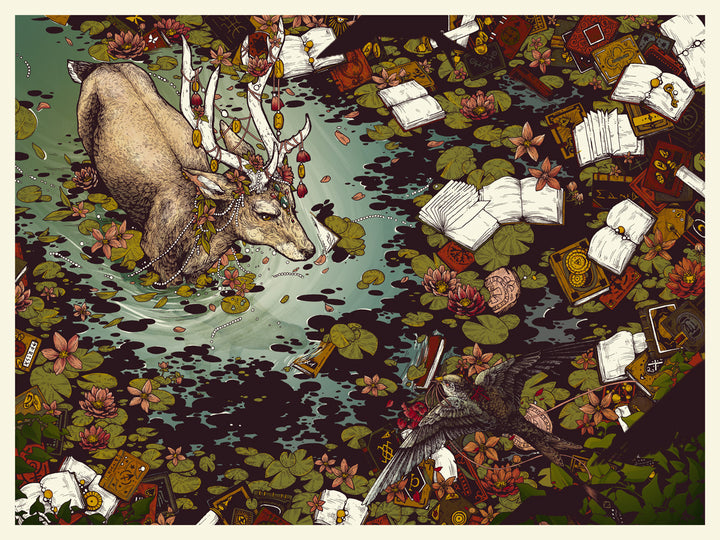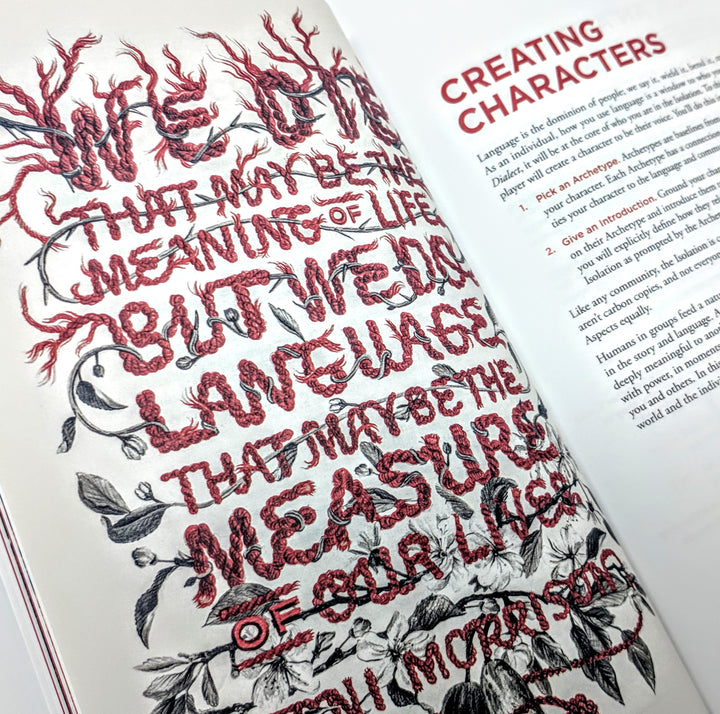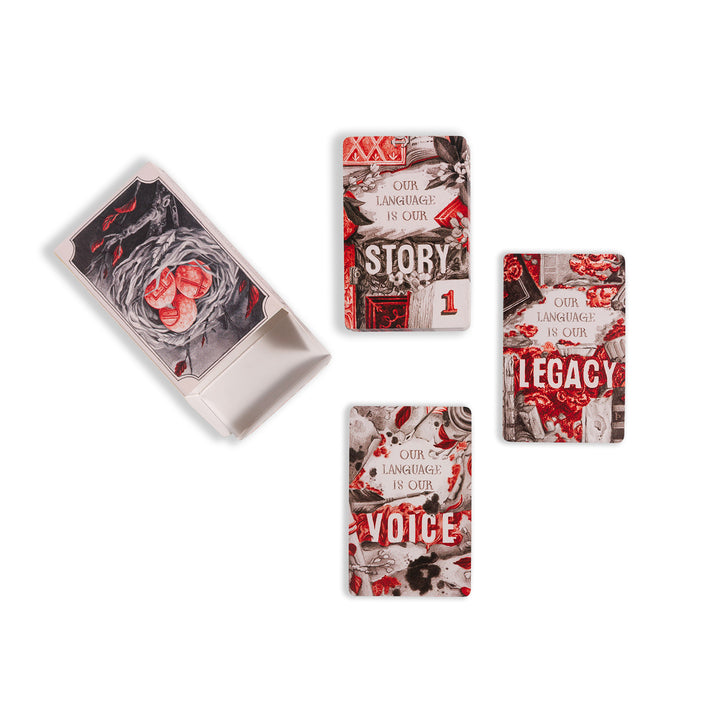
All images were taken from the Dialect game, store, and KS page
I was invited over to a friend’s house with some other friends. There, I knew two of my regular players, and two other folks with little to no experience in TTRPGs, were going to be spending the afternoon with me. Looking to test out a game I have had in my backlog for a while, and intending to bring something unique to the table, I grabbed Dialect.
A brief idea of what Dialect actually is
Dialect is a game that got Kickstarted in 2016, far surpassing the initial goal. The game is GM-less for 3-4 players, intended to be played in a single 3-4 hour session. Developed by linguists Hakan Seyalioglu and Kathryn Hymes, one could know from the start that this was not just another game about creating a story, but one that would focus on dialect and language, and the beauty of it. The real challenge is finding a way to make such a complex topic interesting for the general audience. So adding a bit of roleplay aspects similar to games like Fiasco or For The Queen was a great choice. If you have tried those games before, this one follows the same gameplay style, being depicted as a “story game” instead of a TTRPG.
Together with the other players, you will be worldbuilding and focusing mostly on how language and dialect affect the other aspects of worldbuilding. These will go back to impacting the dialect, causing an endless cycle between the two parts until the end of the game. This is a story about language, and how it dies, so you know for a fact that what you create will not survive.
Now, let’s delve deeper into why I think this is a game I believe you should try.

Art & Layout
Even if this white book doesn’t draw as much attention, the people at Thorny Games managed to make each piece of art stand out. The layout is gorgeous, and the art shows perfectly how to play the game while also providing beautiful imagery to keep you interested in continuing reading. The full-page spreads are filled with colors that make this book instantly become one of the most beautiful ones in my collection. Additionally, the uses of colors by changing the background color from white to red allow readers to fully understand where you should be looking. This is not an artbook, and the layout is quite simple, but it works amazingly and makes it very comfortable to read without spending thousands on art. Definitely a book I will be looking at when designing my own products.

The Rules
As indicated above, this story game involves the players building a dialect together. This might sound super complex, but I assure you it is much simpler than you think. The game includes a summary of the rules that you can download, but to be honest, I found them a bit cumbersome. I would have preferred a single page to print that had all the difficult-to-remember parts. Still, the game recommends learning the game as you go, as some details are difficult to fully grasp just by reading. The examples of play provided, however, do a fantastic job at explaining how each rule is used and how it interacts with the other aspects of the game.
During the entirety of the session, players will be advancing within Ages that show the progress of not only the story, but of the evolution of the language. To start with, players choose a Backdrop that they find interesting, a starting point with all the introductory questions to rapidly get started. The rules provide 4 Core Backdrops, as well as 12 other Contributed Backdrops created by other designers. These last ones are more recommended for players who already have some experience in the game. Even if you play the same Backdrop, you will most certainly live a very different game experience. The randomness instantiated from the cards, as well as people’s thought processes and mood, will always create different results, as it happens with other story games. This guarantees endless replayability, which is always something very cool to find. However, this also means that this game will feel spectacularly well with some player groups, while it may not shine as much with some others.

Aspects and Characters
When you start a game of Dialect, you grab the deck of cards included with it (more on that later) and deal Archetype cards to the players. In addition, players answer the questions from the Backdrop to create Aspects. Aspects are the important points from the community that will affect the dialect you are creating. If we are talking about a community in a tundra region, by answering the questions, it would not be surprising if the Aspects end up being Extreme Cold, Dangerous Fauna, and Lack of Signal. When creating your character by using your archetype, you are tasked to have connections with the existing Aspects in your community, or as this game calls it, your Isolation. Aspects are the main focus in the game, which will help the players constantly come up with new terms to play with.
Gameplay Loop
Once players have prepared the game using the chosen Backdrop, they get to head into the gameplay loop:
- Make a Connection
- Build a Word
- Have a Conversation
In the first step, players choose one card to use from the cards they receive at the start of an Age. They have to tie it to one of the already existing Aspects, thus making a connection. Let’s say the received card is “Friend”, so everyone at the table must brainstorm how to connect that card with one of the Aspects, the player who used it having the final say.
Let’s connect Friend with “Lack of Signal”, indicating that in an Isolation like this, having no signal and living in such a hostile environment, it is always vital to have a Friend go with you anywhere you go in case you need help.
For the second step, now that we have developed a connection, we need to determine amongst everyone which word we can use to define this particular kind of friendship.
Why not name these special friends “Beacon”? I can see that term starting to be applied to these people.
Lastly, it is time to do a bit of roleplaying. The card played indicates a kind of scene to be played out. The one using the card must select the other player characters that make sense to appear in the scene, and the new word must come up in some way, cementing it as an existing word for the players.
That last step of the creation, I saw it as something silly at the beginning, but as the game progressed and new words were created, it was fascinating getting to see us players incorporate all the new words and phrases into our vocabulary in the roleplay scenes. It really is a very unique experience.
Ages
As players keep repeating the gameplay loop, many words end up becoming part of the dialect. Once each player has gone once, the game advances to the next Age. When that happens, something changes for the Isolation; specifically, an Aspect. The Aspect of the players’ choice evolves, following what is prompted in the chosen Backdrop at the start, which will slowly lead to the dialect’s extinction. Once an Aspect is evolved, the rest remain as they are, and the game goes back to the gameplay loop again.
For each of the Ages, new cards are dealt to the players to make a connection. These cards are categorized by the Age they are from, making the game slowly lead you to the death of the dialect.
The Cards
A plethora of cards are part of the Language Deck, offering the Archetype cards to be used within the many ages, and the Legacy cards to use at the end of the game to close the story off. Just like the book, these have an elegant, simple layout, with their back featuring gorgeous art that makes it easy to identify each card type. Most of the cards will not end up being used, granting a huge amount of replayability.
Additionally, some cards interrupt the usual gameplay loop, having special rules appear. For example, the card Misunderstanding allows a player to indicate that a word from the dialect has always been misunderstood and, from now on, it will mean a new thing, altering the entirety of how the dialect might work. You have to create a reason why this happened, adding even more depth to the worldbuilding. The Aspects affect the dialect, which affects the world, which itself affects the dialect and the Aspects again, creating an endless loop of continual worldbuilding.

Playing in a Different Language
As some of you know, I am from Argentina, and we here speak Spanish. With the entirety of the game being in English, the book offers many sections that help create words easily in the English language using the reasoning linguists use. Playing in a different language meant that we could only use some of those tools, but that also helped me better understand how different languages work and how different words are created in each of them. The words we created in Spanish probably wouldn’t be easily created in English, and that is a wondrous experience in itself.
My Experience
I played with these 4 players I indicated above, and we used the Outpost Backdrop, which is the recommended one for first-time players.
Our Isolation was located on Mars, and has been there for the past 5 years, but we have been cut off from communication. The 3 Aspects chosen were “Extreme Cold”, “Mental Health”, and “Terraformation”. 5 characters were defined then: The Artist, creator of ice sculptures for the wealthy; The Mediator, cook of the Isolation that kept everyone together and sparsed rumors; The Star, leader of the Mars Expedition that intended to start life over on the red planet; The Healer, medic of the group and specialist in biology for the terraformation process; and The Fool, bringing some comedy and leisure to the inhabitants here.
Through the creation of words, we understood that the Star started to use the word “calid” to talk about happiness, which got adopted by the inhabitants of the place. With time, the haters of this Star, who was commanding everyone to work harder for a better future, started using the word in a negative way, or to talk down to the wealthy. Some additional words started to appear, talking about the scarcity and surprising findings of resources, having an origin that came from the original aspects. For example, the scarcity of something ended up being the equivalent in English to “undrinkable”, coming from how little drinkable water there was on the planet, which in itself originated from the glaciers at the poles of the planet.
By the start of the second Age, we found out that Earth had already been taken over by AI, and that the machines sent an early stash to Mars with weapons that showcased they were coming to invade the red planet. While the Star kept telling everyone to work hard, promising that people would be able to live together with the machines, a new word was formed “Mullerism” (coming from the Star’s surname Muller), a movement that was all about the need to prepare Mars and prepare for robots to live together with humans. In the meantime, the Fool found that allying with the Artist, they could get access to bonding with the Star and begin their ultimate plan: a huge joke business coming from the inside, while staying on the side of the ruling people. This was immediately seen as part of the Mullerism movement, with people adopting this big joke as a sense of belonging. Meanwhile, the other players took a more active role in acting as the people acted and started a rebellion against the Mullerism and the machines.
The Artist and the Fool had made of the Star an icon by now, creating more new terms to have the people of Mars see her negatively, and as a menace to society. The term of Mullerism rapidly changed from a positive movement to a sign of weakness and deceit, with new terms that started to become part of the rebellion to talk about how they would overthrow the people in power.
By Age 3, the robots finally arrived, starting a new era of humans and machines. This was also the moment Mullerism died, with the Isolation rebelling against the Star and overthrowing her entirely, with the Fool and the Artist as the leaders of the operation, betraying who they once worked for. The machines able to live with ease on the dangerous red planet merged their community with that of our Isolation, having humans lastly combine themselves with machines to endure it. The dialect we have worked so hard to build amongst our 5 hours of play slowly started to disappear with the passing of generations. Now, only my 5 friends and I are left speaking this dialect.

Conclusion
Dialect is a marvel of a game, creating a very harsh story that grows in a very interesting way while also teaching players about the importance of Language. I found myself becoming much more interested in how a language is built and the impact it creates in society. I didn’t even get to detail that about half of the book is about teachings about language, and how important it is, as well as how to easily start building your own dialect in a more “realistic” way. I haven’t fully gotten to read through all of it as they are not integral for playing the game, but it is definitely something I want to check out soon, and play again with that new knowledge!
Now, the game as I said before is not for every group. It can easily lean towards a silly side with some groups, while others can delve into a much more harrowing path with a very depressing ending. However, you will find a ton of fun either way.
You can buy Dialect at Thorney Games’ official website:
This post is brought to you by our wonderful patron Daniel Markwig, supporting us since December 2017! Thanks for helping us keep the stew fires going!

